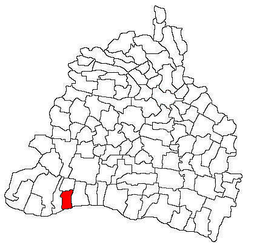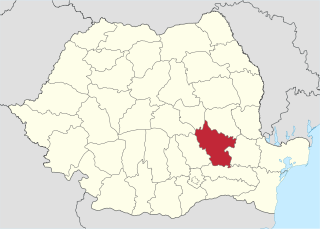
Buzău County is a county (județ) of Romania, in the historical region Muntenia, with the capital city at Buzău.

According to the Moldovan law on territorial administrative organisation, Moldova is divided administratively into the following administrative territorial units: districts, cities/towns and villages. The administrative territorial organization of Moldova is made on 2 levels:
- villages (communes), sectors and cities/towns (municipalities) constitute the first level,
- districts, Chișinău municipality, Bălți municipality and Bender municipality constitute the second level.

The Krashovani are a South Slavic community inhabiting Carașova and Lupac in the Caraș-Severin County within Romanian Banat. They are regarded as and predominantly self-identify as Croats. They are Roman Catholic by faith and speak the Torlakian dialect. Glottolog lists "Karashevski" as sub-type of Croatian language.

Dudeștii Vechi is a commune in Timiș County, Romania. Dudeștii Vechi is mostly populated by Banat Bulgarians (Palćene), a regional minority group of ethnic Bulgarians that profess Roman Catholicism, who came from northern Bulgaria, and who are descendants of Paulicians that settled in the area around 1738. At the 2011 census, the total population of the commune numbered 4203 people.

Atid is a commune in Harghita County, Romania. It lies in the Székely Land, an ethno-cultural region in eastern Transylvania.

A commune is the lowest level of administrative subdivision in Romania. There are 2,686 communes in Romania. The commune is the rural subdivision of a county. Urban areas, such as towns and cities within a county, are given the status of city or municipality.

Romania's administration is relatively centralized and administrative subdivisions are therefore fairly simplified.
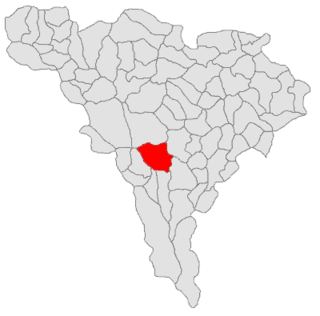
Vințu de Jos, also known as Vinț, is a commune located in the centre of Alba County, Transylvania, Romania. It is composed of eighteen villages: Câmpu Goblii, Ciocașu, Crișeni (Krieschen), Dealu Ferului, Gura Cuțului (Gurrenkutz), Hațegana (Hetzingen), Inuri, Laz (Slawendorf), Mătăcina (Mattatschin), Mereteu, Pârău lui Mihai (Michelsdorf), Poienița (Pojenitz), Stăuini (Stabing), Valea Goblii, Valea lui Mihai (Michaelsdorf), Valea Vințului, Vințu de Jos and Vurpăr.

Socol is a commune in Caraș-Severin County, Romania. In 2011, the population of the commune numbered 1,873 people and its population was ethnically mixed. It is composed of five villages: Baziaș, Câmpia, Pârneaura, Socol and Zlatița.
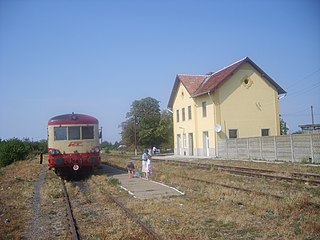
Jamu Mare is a commune in Timiș County, Banat, Romania.

Căbești is a commune in Bihor County, Crișana, Romania, around 13 kilometers north of the town of Beiuș.

Ciucsângeorgiu is a commune in Harghita County, Romania. It lies in the Székely Land, an ethno-cultural region in eastern Transylvania.
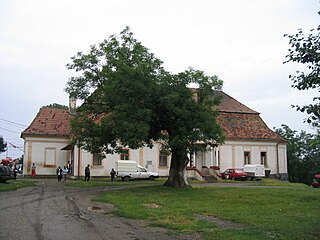
Voivodeni is a commune in Mureș County, Romania. It is composed of two villages, Toldal (Toldalag) and Voivodeni. The former village is much less populated than the latter.

Măeriște is a commune located in Sălaj County, Romania.

Căpâlna is a commune in Bihor County, Crișana, Romania with a population of 1,663 people (2011). It is composed of five villages: Căpâlna, Ginta (Gyanta), Rohani (Rohány), Săldăbagiu Mic (Körösszáldobágy) and Suplacu de Tinca (Tenkeszéplak). The commune is situated in the southern part of Bihor County, on the right bank of the Crișul Negru, at a distance of 60 km from Oradea, 26 km from Beiuș and 40 km from Salonta.

Piscu Vechi is a commune in Dolj County, Oltenia, Romania with a population of 2,950 people. It is composed of two villages, Piscu Vechi and Pisculeț. It also included Ghidici village until 2004, when it was split off to form a separate commune.

Olari is a commune in Prahova County, Romania. It is composed of three villages: Fânari, Olari and Olarii Vechi. Until 2004, these belonged to Gherghița Commune, when they were split off to form a separate commune.

Local elections were held in Romania on 5 June, 2016.
According to the Moldovan law on territorial administrative organisation, two or more villages can form together a commune.
